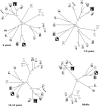Perception of everyday sounds: a developmental study of a free sorting task
- PMID: 25643286
- PMCID: PMC4313934
- DOI: 10.1371/journal.pone.0115557
Perception of everyday sounds: a developmental study of a free sorting task
Abstract
Objectives: The analysis of categorization of everyday sounds is a crucial aspect of the perception of our surrounding world. However, it constitutes a poorly explored domain in developmental studies. The aim of our study was to understand the nature and the logic of the construction of auditory cognitive categories for natural sounds during development. We have developed an original approach based on a free sorting task (FST). Indeed, categorization is fundamental for structuring the world and cognitive skills related to, without having any need of the use of language. Our project explored the ability of children to structure their acoustic world, and to investigate how such structuration matures during normal development. We hypothesized that age affects the listening strategy and the category decision, as well as the number and the content of individual categories.
Design: Eighty-two French children (6-9 years), 20 teenagers (12-13 years), and 24 young adults participated in the study. Perception and categorization of everyday sounds was assessed based on a FST composed of 18 different sounds belonging to three a priori categories: non-linguistic human vocalizations, environmental sounds, and musical instruments.
Results: Children listened to the sounds more times than older participants, built significantly more classes than adults, and used a different strategy of classification. We can thus conclude that there is an age effect on how the participants accomplished the task. Analysis of the auditory categorization performed by 6-year-old children showed that this age constitutes a pivotal stage, in agreement with the progressive change from a non-logical reasoning based mainly on perceptive representations to the logical reasoning used by older children. In conclusion, our results suggest that the processing of auditory object categorization develops through different stages, while the intrinsic basis of the classification of sounds is already present in childhood.
Conflict of interest statement
Figures






Similar articles
-
Categorization of everyday sounds by cochlear implanted children.Sci Rep. 2019 Mar 5;9(1):3532. doi: 10.1038/s41598-019-39991-9. Sci Rep. 2019. PMID: 30837546 Free PMC article.
-
Categorization of common sounds by cochlear implanted and normal hearing adults.Hear Res. 2016 May;335:207-219. doi: 10.1016/j.heares.2016.03.007. Epub 2016 Apr 2. Hear Res. 2016. PMID: 27050944
-
Sounds of Hidden Agents: The Development of Causal Reasoning About Musical Sounds.Dev Sci. 2025 Jul;28(4):e70021. doi: 10.1111/desc.70021. Dev Sci. 2025. PMID: 40313093 Free PMC article.
-
Behavioral semantics of learning and crossmodal processing in auditory cortex: the semantic processor concept.Hear Res. 2011 Jan;271(1-2):3-15. doi: 10.1016/j.heares.2010.10.006. Epub 2010 Oct 29. Hear Res. 2011. PMID: 20971178 Review.
-
Developmental origins of natural sound perception.Front Psychol. 2024 Dec 11;15:1474961. doi: 10.3389/fpsyg.2024.1474961. eCollection 2024. Front Psychol. 2024. PMID: 39726626 Free PMC article. Review.
Cited by
-
Categorization of everyday sounds by cochlear implanted children.Sci Rep. 2019 Mar 5;9(1):3532. doi: 10.1038/s41598-019-39991-9. Sci Rep. 2019. PMID: 30837546 Free PMC article.
-
A study of voice and non-voice processing in Prader-Willi syndrome.Orphanet J Rare Dis. 2020 Jan 20;15(1):22. doi: 10.1186/s13023-020-1298-8. Orphanet J Rare Dis. 2020. PMID: 31959191 Free PMC article.
-
Toward a Nonspeech Test of Auditory Cognition: Semantic Context Effects in Environmental Sound Identification in Adults of Varying Age and Hearing Abilities.PLoS One. 2016 Nov 28;11(11):e0167030. doi: 10.1371/journal.pone.0167030. eCollection 2016. PLoS One. 2016. PMID: 27893791 Free PMC article.
-
Functional Reorganization of the Central Auditory System in Children with Single-Sided Deafness: A Protocol Using fNIRS.Brain Sci. 2022 Mar 22;12(4):423. doi: 10.3390/brainsci12040423. Brain Sci. 2022. PMID: 35447955 Free PMC article.
References
-
- Kail M, Fayol M (2000) L’acquisition du langage, tome 1: Le langage en émergence De la naissance à trois ans. Paris: Presses Universitaires de France; 10.1016/j.arcped.2014.10.027 - DOI
-
- Trawick-Smith J (2003) Early childhood development: A multicultural perspective 3rd ed. New Jersey: Merrill Prentice Hall;
-
- Jusczyk PW, Aslin RN (1995) Infants’ detection of the sound patterns of words in fluent speech. Cognitive psychology 29: 1–23. - PubMed
-
- Kuhl PK (2004) Early language acquisition: Cracking the speech code. Nature Reviews Neuroscience 5: 831–843. - PubMed
Publication types
MeSH terms
LinkOut - more resources
Full Text Sources
Other Literature Sources
Miscellaneous

